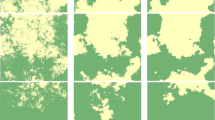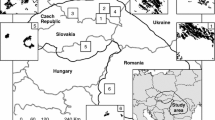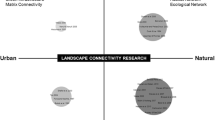Abstract
Landscape connectivity, defined as the degree to which the landscape facilitates or impedes movement among resource patches, has been considered to be a key issue for biodiversity conservation. However, the use of landscape connectivity measurements has been strongly criticised due to uncertainties in the methods used and the lack of validation. Moreover, measurements are typically restricted to the population level, whereas management is generally carried out at the community level. Here, we used satellite imagery and network metrics to predict the landscape connectivity at community level for semi-natural herbaceous patches in an urban area near Paris (France). We tested different measurement methods, both taking into account and ignoring the spatial heterogeneity of matrix resistance estimated by the normalised difference vegetation index (NDVI), and quantifying the link strength between patches with the shortest path and flow metrics. We assessed the fit of these connectivity predictions with empirical data on plant communities embedded in an urban matrix. Our results indicate that the best fit with the empirical data is obtained when the connectivity is estimated with the flow metric and takes into account the matrix heterogeneity. Overall, our study helps to estimate the landscape connectivity of urban areas and makes recommendations for ways in which we might optimise landscape planning with respect to conservation of urban biodiversity.



Similar content being viewed by others
References
Adriaensen F, Chardon JP, De Blust G, Swinnen E, Villalba S, Gulinck H, Matthysen E (2003) The application of ‘least-cost’ modelling as a functional landscape model. Landsc Urban Plan 64:233–247
Angold PG, Sadler JP, Hill MO, Pullin A, Rushton S, Austin K, Small E, Wood B, Wadsworth R, Sanderson R, Thompson K (2006) Biodiversity in urban habitat patches. Sci Total Environ 360:196–204
Baldwin RF, de Maynadier PG (2009) Assessing threats to pool-breeding amphibian habitat in an urbanizing landscape. Biol Cons 142:1628–1638
Beier P, Majka DR, Newell SL (2009) Uncertainty analysis of least-cost modeling for designing wildlife linkages. Ecol Appl 19:2067–2077
Beier P, Spencer W, Baldwin RF, McRae BH (2011) Toward best practices for developing regional connectivity maps. Cons Biol 25:879–892
Belisle M (2005) Measuring landscape connectivity: the challenge of behavioral landscape ecology. Ecology 86:1988–1995
Bunn AG, Urban DL, Keitt TH (2000) Landscape connectivity: a conservation application of graph theory. J Environ Manage 59:265–278
Butts CT (2008) Social network analysis with sna. J Stat Softw 24:1–51
Calabrese JM, Fagan WF (2004) A comparison-shopper’s guide to connectivity metrics. Front Ecol Environ 2:529–536
Campbell Grant EH, Lowe WH, Fagan WF (2007) Living in the branches: population dynamics and ecological processes in dendritic networks. Ecol Lett 10:165–175
Castellon TD, Sieving KE (2006) An experimental test of matrix permeability and corridor use by an endemic understory bird. Conserv Biol 20:135–145
Compton BW, McGarigal K, Cushman SA, Gamble LR (2007) A resistant-kernel model of connectivity for amphibians that breed in vernal pools. Cons Biol 21:788–799
Conrad JM, Gomes CP, van Hoeve W-J, Sabharwal A, Suter JF (2012) Wildlife corridors as a connected subgraph problem. J Environ Econ Manage 63:1–18
Conservatoire botanique national du Bassin parisien (CBNBP) Muséum national d’Histoire naturelle (2008). http://cbnbp.mnhn.fr/cbnbp/. Accessed Dec 2011
Coulon A, Cosson JF, Angibault JM, Cargnelutti B, Galan M, Morellet N, Petit E, Aulagnier S, Hewison AJM (2004) Landscape connectivity influences gene flow in a roe deer population inhabiting a fragmented landscape: an individual-based approach. Mol Ecol 13:2841–2850
Crooks KR, Sanjayan M (2006) Connectivity conservation. Cambridge University Press, Cambridge
Doerr VAJ, Barrett T, Doerr ED (2011) Connectivity, dispersal behaviour and conservation under climate change: a response to Hodgson et al. J Appl Ecol 48:143–147
Fahrig L (2007) Non-optimal animal movement in human-altered landscapes. Funct Ecol 21:1003–1015
Galpern P, Manseau M, Fall A (2011) Patch-based graphs of landscape connectivity: a guide to construction, analysis and application for conservation. Biol Conserv 144:44–55
Gaston KJ (2011) Common ecology. Bioscience 61:354–362
Gonzales E, Gergel S (2007) Testing assumptions of cost surface analysis-a tool for invasive species management. Landscape Ecol 22:1155–1168
Grimm NB, Morgan Grove J, Pockett STA, Redman CL (2000) Integrated approaches to long-term studies of urban ecological systems. Bioscience 50:571–584
Hodgson JA, Thomas CD, Wintle BA, Moilanen A (2009) Climate change, connectivity and conservation decision making: back to basics. J Appl Ecol 46:964–969
Hodgson JA, Moilanen A, Wintle BA, Thomas CD (2011) Habitat area, quality and connectivity: striking the balance for efficient conservation. J Appl Ecol 48:148–152
IAURIF (2000) Institute for Planning and Development of the Paris Ile-de-France Region. http://www.iau-idf.fr/fileadmin/Etudes/etude_799/doc/memento_1_Indice-vegetation.pdf. Accessed Dec 2011
INSEE (1999) National Institute for Statistics and Economic Studies. http://www.insee.fr. Accessed Dec 2011
Kerr JT, Ostrovsky M (2003) From space to species: ecological applications for remote sensing. Trends Ecol Evol 18:299–305
Kleyer M (1995) Biological traits of vascular plants. A database—Arbeitsberichte Inst. f. Landschaftsplanung u. Ökologie Univ. Stuttgart, N.F. Bd. 2. 1995. ISSN 0941-651X
MacArthur RH, Wilson EO (1967) The theory of island biogeography. Princeton University Press, Princeton
Magle S, Theobald D, Crooks K (2009) A comparison of metrics predicting landscape connectivity for a highly interactive species along an urban gradient in Colorado, USA. Landscape Ecol 24:267–280
McKinney ML (2002) Urbanization, biodiversity, and conservation. Bioscience 52:883–890
McRae BH, Dickson BG, Keitt TH, Shah VB (2008) Using circuit theory to model connectivity in ecology, evolution, and conservation. Ecology 89:2712–2724
Merriam G (1984) Connectivity: a fundamental ecological characteristic of landscape pattern. Proceedings of the first international seminar on methodology in landscape ecological research and planning. Theme I: Landscape Ecological Concepts, p 5–16
Myneni RB, Hall FG, Sellers PJ, Marshak AL (1995) The interpretation of spectral vegetation indexes. IEEE Trans Geosci Remote Sensing 33:481–486
Oksanen J, Kindt R, O’Hara R (2005) Vegan: Community Ecology Package
Pascual-Hortal L, Saura S (2006) Comparison and development of new graph-based landscape connectivity indices: towards the priorization of habitat patches and corridors for conservation. Landscape Ecol 21:959–967
Pettorelli N, Vik JO, Mysterud A, Gaillard J-M, Tucker CJ, Stenseth NC (2005) Using the satellite-derived NDVI to assess ecological responses to environmental change. Trends Ecol Evol 20:503–510
Prevedello JA, Vieira MV (2010) Does the type of matrix matter? A quantitative review of the evidence. Biodivers Conserv 19:1205–1223
Prugh LR, Hodges KE, Sinclair ARE, Brashares JS (2008) Effect of habitat area and isolation on fragmented animal populations. Proc Natl Acad Sci 105:20770–20775
Purevdorj T, Tateishi R, Ishiyama T, Honda Y (1998) Relationships between percent vegetation cover and vegetation indices. Int J Remote Sens 19:3519–3535
Ray N, Lehmann A, Joly P (2002) Modeling spatial distribution of amphibian populations: a GIS approach based on habitat matrix permeability. Biodivers Conserv 11:2143–2165
Rayfield B, Fortin M-J, Fall A (2011) Connectivity for conservation: a framework to classify network measures. Ecology 92:847–858
Richardson DM, Pyšek P, Rejmánek M, Barbour MG, Panetta D, West CJ (2000) Naturalization and invasion of alien plants: concepts and definitions. Divers Distrib 6:93–107
Ricketts TH (2001) The matrix matters: effective isolation in fragmented landscapes. Am Nat 158:87–99
Saura S, Rubio L (2010) A common currency for the different ways in which patches and links can contribute to habitat availability and connectivity in the landscape. Ecography 33:523–537
Saure C (1996) Urban habitats for bees: the example of the city of Berlin. In: Matheson A, Buchmann SL, O’Toole C, Westrich P, Williams IH (eds) The conservation of bees. Academic Press, London, pp 47–53
Sawyer SC, Epps CW, Brashares JS (2011) Placing linkages among fragmented habitats: do least-cost models reflect how animals use landscapes? J Appl Ecol 48:668–678
Schleicher A, Biedermann R, Kleyer M (2011) Dispersal traits determine plant response to habitat connectivity in an urban landscape. Landscape Ecol 26:529–540
Shanahan DF, Miller C, Possingham HP, Fuller RA (2011) The influence of patch area and connectivity on avian communities in urban revegetation. Biol Cons 144:722–729
SOeS (2010) L’environnement en France Edition 2010. Ministère de l’Ecologie, de l’Energie, du Developpement durable et de la Mer—Commissariat général au développement durable—Service de l’observation et des statistiques. http://www.statistiques.developpementdurable.gouv.fr. Accessed Dec 2011
Soons MB, Nathan R, Katul GG (2004) Human effects on long-distance wind dispersal and colonization by grassland plants. Ecology 85:3069–3079
Sun D, Dawson R, Li H, Wei R, Li B (2006) A landscape connectivity index for assessing desertification: a case study of Minqin County, China. Landscape Ecol 22:531–543
Taylor PD, Fahrig L, Henein K, Merriam G (1993) Connectivity is a vital element of landscape structure. Oikos 68:571–573
Theobald DM, Reed SE, Fields K, Soulé M (2012) Connecting natural landscapes using a landscape permeability model to prioritize conservation activities in the United States. Conserv Lett 5:123–133
Thomson FJ, Moles AT, Auld TD, Kingsford RT (2011) Seed dispersal distance is more strongly correlated with plant height than with seed mass. J Ecol 99:1299–1307
Tischendorf L, Fahrig L (2000) On the usage and measurement of landscape connectivity. Oikos 90:7–19
Tzoulas K, Korpela K, Venn S, Yli-Pelkonen V, Kazmierczak A, Niemela J, James P (2007) Promoting ecosystem and human health in urban areas using green infrastructure: a literature review. Landsc Urban Plan 81:167–178
Umetsu F, Pardini R (2006) Small mammals in a mosaic of forest remnants and anthropogenic habitats—evaluating matrix quality in an Atlantic forest landscape. Landscape Ecol 22:517–530
Urban D, Keitt T (2001) Landscape connectivity: a graph-theoretic perspective. Ecology 82:1205–1218
Von der Lippe M, Kowarik I (2008) Do cities export biodiversity? Traffic as dispersal vector across urban-rural gradients. Divers Distrib 14:18–25
Watling JI, Nowakowski AJ, Donnelly MA, Orrock JL (2011) Meta-analysis reveals the importance of matrix composition for animals in fragmented habitat. Glob Ecol Biogeogr 20:209–217
West DB (1996) Introduction to graph theory. Prentice Hall, Upper Saddle River
Acknowledgments
We thank Sébastien Filoche of the CBNBP, who carried out the floristic inventories and the habitat mapping in the territory studied. This study was financially supported by the Observatoire Départemental de la Biodiversité Urbaine (ODBU) from the Seine-Saint-Denis district. We thank Antoine Roulet of the ODBU to its participation at the data analysis and habitat mapping. We finally thank the Institute for Planning and Development of the Paris Ile-de-France Region (IAU) to give us an access to the NDVI.
Author information
Authors and Affiliations
Corresponding author
Rights and permissions
About this article
Cite this article
Muratet, A., Lorrillière, R., Clergeau, P. et al. Evaluation of landscape connectivity at community level using satellite-derived NDVI. Landscape Ecol 28, 95–105 (2013). https://doi.org/10.1007/s10980-012-9817-1
Received:
Accepted:
Published:
Issue Date:
DOI: https://doi.org/10.1007/s10980-012-9817-1




